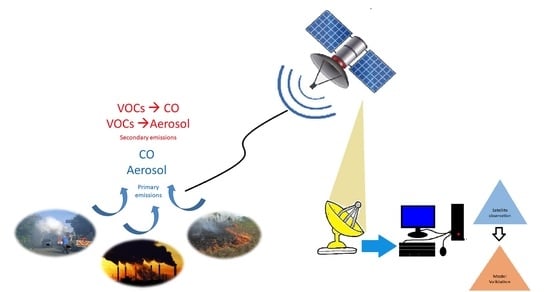Evaluating Carbon Monoxide and Aerosol Optical Depth Simulations from CAM-Chem Using Satellite Observations
Abstract
:1. Introduction
2. Materials and Methods
2.1. Satellite Data
2.1.1. CO from MOPITT
2.1.2. FRP from MODIS
2.1.3. AOD from MODIS
2.2. CAM-Chem Model
2.2.1. CAM-Chem Model Introduction
2.2.2. CAM-Chem Model Simulation
2.3. Calculating RMSE and Pearson’s Correlation Coefficient
3. Results and Discussion
3.1. Seasonal and Spatial Variations of Global CO (Observations and Simulations)
3.2. Seasonal and Spatial Variations of Global AOD (Observations and Simulations)
3.3. Modeled Results vs. Observation: Correlation and RMSE
3.4. FRP vs. CO vs. AOD Correlation
4. Conclusions
- (1)
- In the Northern Hemisphere, the highest AOD concentrations are observed during March–April–May and June–July–August. In the Southern Hemisphere, the highest AOD concentrations are observed mainly during August–September–October. Over South America, the highest AOD values are observed over subtropical Brazil, Paraguay and Bolivia.
- (2)
- Although both configurations of the model reasonably simulated the spatial and temporal distributions of CO and AOD concentrations, the model has difficulty in capturing the exact location of the maxima of the seasonal AOD distributions. CO concentrations are overestimated over central China, central Africa and equatorial regions of the Atlantic and western Pacific Oceans. The inclusion of stratospheric chemistry resulted in a significant decrease in this positive bias, due to the CO dry deposition, which is not present in the configuration using only tropospheric chemistry, and also due to a greater CO loss resulting from the chemical reactions and a shorter lifetime of these species in this configuration. AOD is overestimated over desert regions of Africa, the Middle East and Asia in both experiments, but the positive bias is even higher in these regions in the version with added stratospheric chemistry. In contrast, AOD is underestimated over regions associated with high anthropogenic activity, such as eastern China and northern India. During the rapid industrialization in the previous decades, east Asia shows differences of up to 500% for CO emissions compared to the REAS and EDGAR version 4.2, as reported in [111].
- (3)
- Both model configurations considered in this study resulted in an underestimation of the CO concentrations over Canada, Europe and Russia. There was no CO increase in the period of study in these regions, indicating that anthropogenic emissions may be underestimated. Both versions of the model show positive correlations between modeled and observed CO (ranging from 0.4 to 0.8) for the whole globe, except for the coast of California, south–central Argentina, the Sahel region and east Asia (where the correlation is negative).
- (4)
- High correlations were observed between FRP and CO in the western Amazon region, such as in the Brazilian states of Rondônia, Acre, the south of Pará and Amazonas, as well as at the border between Brazil, Bolivia and Peru. This region corresponds to the deforestation arc located in the fringes of the Amazon Forest, where fires present a seasonal and interannual variability that is directly associated with land use change and agriculture expansion.
- (5)
- High correlations were observed between CO and aerosols (AOD) from biomass burning at the transition between the forest and savanna environments over east and central Africa. It is also possible to observe the transport of these pollutants from the African continent to the Brazilian coast.
- (6)
- Savanna and Tropical forests, as in South America (western Amazon), Central America, Africa, Australia, and Southeast Asia, show a higher FRP x CO correlation than FRP x AOD. In contrast, boreal forests in Russia, particularly in Siberia, show a higher FRP x AOD correlation compared to FRP x CO. This may be related to differences in vegetation, temperature, and humidity at the time of burning. In tropical forests, it is likely that CO production is favored compared to aerosols, and in temperate forests, aerosol production is more likely than CO when compared to tropical forests. On the east coast of the United States and the eastern border of the USA with Canada, there is a high correlation of CO x AOD and a low correlation between FRP with both CO and AOD. It also occurs in eastern China, on the border between China, Russia, Mongolia, North India, and China. Therefore, such emissions in these regions are not generated by forest fires but by thermoelectric industries, other types of industries, and vehicular emissions since these are densely populated regions.
Supplementary Materials
Author Contributions
Funding
Informed Consent Statement
Data Availability Statement
Acknowledgments
Conflicts of Interest
References
- Andreae, M.O.; Rosenfeld, D.; Artaxo, P.; Costa, A.A.; Frank, G.P.; Longo, K.M.; Silva-Dias, M.A.F. Smoking Rain Clouds over the Amazon. Science 2004, 303, 1337–1342. [Google Scholar] [CrossRef] [Green Version]
- Freitas, S.R.; Longo, K.M.; Dias, M.A.F.S.; Dias, P.L.S.; Chatfield, R.; Prins, E.; Artaxo, P.; Grell, G.A.; Recuero, F.S. Monitoring the transport of biomass burning emissions in South America. Environ. Fluid Mech. 2005, 5, 135–167. [Google Scholar] [CrossRef] [Green Version]
- Wu, S.; Mickley, L.J.; Kaplan, J.O.; Jacob, D.J. Impacts of changes in land use and land cover on atmospheric chemistry and air quality over the 21st century. Atmos. Chem. Phys. 2012, 12, 1597–1609. [Google Scholar] [CrossRef] [Green Version]
- Susskind, J.; Barnet, C.; Blaisdell, J.; Iredell, L.; Keita, F.; Kouvaris, L.; Molnar, G.; Chahine, M. Accuracy of geophysical parameters derived from Atmospheric Infrared Sounder/Advanced Microwave Sounding Unit as a function of fractional cloud cover. J. Geophys. Res. 2006, 111. [Google Scholar] [CrossRef] [Green Version]
- Xiong, X.; Barnet, C.D.; Zhuang, Q.; Machida, T.; Sweeney, C.; Patra, P.K. Mid-upper tropospheric methane in the high Northern Hemisphere: Spaceborne observations by AIRS, aircraft measurements, and model simulations. J. Geophys. Res. Space Phys. 2010, 115, 19309. [Google Scholar] [CrossRef] [Green Version]
- Granier, C.; Bessagnet, B.; Bond, T.; D’Angiola, A.; Van Der Gon, H.D.; Frost, G.J.; Heil, A.; Kaiser, J.; Kinne, S.; Klimont, Z.; et al. Evolution of anthropogenic and biomass burning emissions of air pollutants at global and regional scales during the 1980–2010 period. Clim. Chang. 2011, 109, 163–190. [Google Scholar] [CrossRef]
- Van Der Werf, G.R.; Randerson, J.T.; Giglio, L.; Van Leeuwen, T.T.; Chen, Y.; Rogers, B.M.; Mu, M.; Van Marle, M.J.E.; Morton, D.C.; Collatz, G.J.; et al. Global fire emissions estimates during 1997–2016. Earth Syst. Sci. Data 2017, 9, 697–720. [Google Scholar] [CrossRef] [Green Version]
- Crutzen, P.J.; Andreae, M.O. Biomass Burning in the Tropics: Impact on Atmospheric Chemistry and Biogeochemical Cycles. Science 1990, 250, 1669–1678. [Google Scholar] [CrossRef]
- Sinha, P.; Hobbs, P.V.; Yokelson, R.J.; Blake, D.R.; Gao, S. Distributions of trace gases and aerosols during the dry biomass burning season in southern Africa. J. Geophys. Res. Space Phys. 2003, 108, 4536. [Google Scholar] [CrossRef] [Green Version]
- Kganyago, M.; Shikwambana, L. Assessing Spatio-Temporal Variability of Wildfires and their Impact on Sub-Saharan Ecosystems and Air Quality Using Multisource Remotely Sensed Data and Trend Analysis. Sustainability 2019, 11, 6811. [Google Scholar] [CrossRef] [Green Version]
- Bremer, H.; Kar, J.; Drummond, J.R.; Nichitu, F.; Zou, J.; Liu, J.; Gille, J.C.; Deeter, M.N.; Francis, G.; Ziskin, D.; et al. Spatial and temporal variation of MOPITT CO in Africa and South America: A comparison with SHADOZ ozone and MODIS aerosol. J. Geophys. Res. Space Phys. 2004, 109. [Google Scholar] [CrossRef]
- Zheng, B.; Chevallier, F.; Yin, Y.; Ciais, P.; Fortems-Cheiney, A.; Deeter, M.N.; Parker, R.J.; Wang, Y.; Worden, H.M.; Zhao, Y. Global atmospheric carbon monoxide budget 2000–2017 inferred from multi-species atmospheric inversions. Earth Syst. Sci. Data 2019, 11, 1411–1436. [Google Scholar] [CrossRef] [Green Version]
- Liu, J.; Drummond, J.R.; Li, Q.; Gille, J.C.; Ziskin, D.C. Satellite mapping of CO emission from forest fires in Northwest America using MOPITT measurements. Remote Sens. Environ. 2005, 95, 502–516. [Google Scholar] [CrossRef]
- Zheng, B.; Chevallier, F.; Ciais, P.; Yin, Y.; Deeter, M.N.; Worden, H.M.; Wang, Y.; Zhang, Q.; He, K. Rapid decline in carbon monoxide emissions and export from East Asia between years 2005 and 2016. Environ. Res. Lett. 2018, 13, 044007. [Google Scholar] [CrossRef] [Green Version]
- Yin, S.; Wang, X.; Zhang, X.; Guo, M.; Miura, M.; Xiao, Y. Influence of biomass burning on local air pollution in mainland Southeast Asia from 2001 to 2016. Environ. Pollut. 2019, 254, 112949. [Google Scholar] [CrossRef] [PubMed]
- Paton-Walsh, C.; Deutscher, N.M.; Griffith, D.W.T.; Forgan, B.W.; Wilson, S.R.; Jones, N.B.; Edwards, D.P. Trace gas emissions from savanna fires in northern Australia. J. Geophys. Res. 2010, 115, 16314. [Google Scholar] [CrossRef] [Green Version]
- Yurganov, L.N.; Duchatelet, P.; Dzhola, A.V.; Edwards, D.P.; Hase, F.; Kramer, I.; Mahieu, E.; Mellqvist, J.; Notholt, J.; Novelli, P.C.; et al. Increased Northern Hemispheric carbon monoxide burden in the troposphere in 2002 and 2003 detected from the ground and from space. Atmos. Chem. Phys. Discuss. 2005, 5, 563–573. [Google Scholar] [CrossRef] [Green Version]
- Levine, J.S.; Iii, W.R.C.; Winsted, E.L.; Stocks, B.J. Biomass Burning and Global Change; AIP Publishing: Melville, NY, USA, 1992; Volume 277, pp. 131–139. [Google Scholar]
- Burling, I.R.; Yokelson, R.J.; Griffith, D.W.T.; Johnson, T.J.; Veres, P.; Roberts, J.M.; Warneke, C.; Urbanski, S.P.; Reardon, J.; Weise, D.R.; et al. Laboratory measurements of trace gas emissions from biomass burning of fuel types from the southeastern and southwestern United States. Atmos. Chem. Phys. Discuss. 2010, 10, 11115–11130. [Google Scholar] [CrossRef] [Green Version]
- Kaufman, Y.J.; Tucker, C.J.; Fung, I. Remote sensing of biomass burning in the tropics. J. Geophys. Res. Athmos. 1990, 95, 9927–9939. [Google Scholar] [CrossRef]
- Pereira, G.; Freitas, S.R.; Moraes, E.C.; Ferreira, N.J.; Shimabukuro, Y.E.; Rao, V.B.; Longo, K.M. Estimating trace gas and aerosol emissions over South America: Relationship between fire radiative energy released and aerosol optical depth observations. Atmos. Environ. 2009, 43, 6388–6397. [Google Scholar] [CrossRef]
- Kaufman, Y.J.; Kleidman, R.G.; King, M.D. SCAR-B fires in the tropics: Properties and remote sensing from EOS-MODIS. J. Geophys. Res. Space Phys. 1998, 103, 31955–31968. [Google Scholar] [CrossRef]
- Kaufman, Y.J.; Justice, C.O.; Flynn, L.P.; Kendall, J.D.; Prins, E.M.; Giglio, L.; Ward, D.E.; Menzel, W.P.; Setzer, A.W. Potential global fire monitoring from EOS-MODIS. J. Geophys. Res. Atmos. 1998, 103, 32215–32238. [Google Scholar] [CrossRef]
- Artaxo, P.; Martins, J.V.; Yamasoe, M.; Procópio, A.S.; Pauliquevis, T.; Andreae, M.O.; Guyon, P.; Gatti, L.V.; Leal, A.M.C. Physical and chemical properties of aerosols in the wet and dry seasons in Rondônia, Amazonia. J. Geophys. Res. Space Phys. 2002, 107, LBA 49-1. [Google Scholar] [CrossRef]
- Jacobson, M.Z. Atmospheric Pollution: History, Science, and Regulation, 1st ed.; Cambridge University Press: New York, NY, USA, 2002; ISBN 978-0-521-01044-3. [Google Scholar]
- Rosenfeld, D. TRMM observed first direct evidence of smoke from forest fires inhibiting rainfall. Geophys. Res. Lett. 1999, 26, 3105–3108. [Google Scholar] [CrossRef]
- Sarangi, C.; Tripathi, S.N.; Kanawade, V.P.; Koren, I.; Pai, D.S. Investigation of the aerosol–cloud–rainfall association over the Indian summer monsoon region. Atmos. Chem. Phys. Discuss. 2017, 17, 5185–5204. [Google Scholar] [CrossRef] [Green Version]
- Collins, W.D.; Rasch, P.J.; Eaton, B.E.; Khattatov, B.V.; Lamarque, J.-F.; Zender, C. Simulating aerosols using a chemical transport model with assimilation of satellite aerosol retrievals: Methodology for INDOEX. J. Geophys. Res. Space Phys. 2001, 106, 7313–7336. [Google Scholar] [CrossRef] [Green Version]
- Barbu, A.L.; Segers, A.J.; Schaap, M.; Heemink, A.W.; Builtjes, P.J.H. A multi-component data assimilation experiment directed to sulphur dioxide and sulphate over Europe. Atmos. Environ. 2009, 43, 1622–1631. [Google Scholar] [CrossRef]
- Bocquet, M.; Elbern, H.; Eskes, H.; Hirtl, M.; Žabkar, R.; Carmichael, G.R.; Flemming, J.; Inness, A.; Pagowski, M.; Camaño, J.L.P.; et al. Data assimilation in atmospheric chemistry models: Current status and future prospects for coupled chemistry meteorology models. Atmos. Chem. Phys. 2015, 15, 5325–5358. [Google Scholar] [CrossRef] [Green Version]
- Neto, O.L.D.M.; Coutinho, M.M.; Marengo, J.A.; Capistrano, V.B. The impacts of a plume-rise scheme on earth system modeling: Climatological effects of biomass aerosols on the surface temperature and energy budget of South America. Theor. Appl. Clim. 2017, 129, 1035–1044. [Google Scholar] [CrossRef]
- Wang, H.; Naghavi, M.; Allen, C.; Barber, R.M.; Bhutta, Z.A.; Casey, D.C.; Charlson, F.J.; Chen, A.Z.; Coates, M.M.; Coggeshall, M.; et al. Global, regional, and national life expectancy, all-cause mortality, and cause-specific mortality for 249 causes of death, 1980–2015: A systematic analysis for the Global Burden of Disease Study 2015. Lancet 2016, 388, 1459–1544. [Google Scholar] [CrossRef] [Green Version]
- Klimont, Z.; Kupiainen, K.; Heyes, C.; Purohit, P.; Cofala, J.; Rafaj, P.; Borken-Kleefeld, J.; Schöpp, W. Global anthropogenic emissions of particulate matter including black carbon. Atmos. Chem. Phys. Discuss. 2017, 17, 8681–8723. [Google Scholar] [CrossRef] [Green Version]
- Worden, H.M.; Deeter, M.N.; Frankenberg, C.; George, M.; Nichitiu, F.; Worden, J.; Aben, I.; Bowman, K.W.; Clerbaux, C.; Coheur, P.-F.; et al. Decadal record of satellite carbon monoxide observations. Atmos. Chem. Phys. 2013, 13, 837–850. [Google Scholar] [CrossRef] [Green Version]
- Deeter, M.N.; Martínez-Alonso, S.; Edwards, D.P.; Emmons, L.K.; Gille, J.C.; Worden, H.M.; Sweeney, C.; Pittman, J.V.; Daube, B.C.; Wofsy, S.C. The MOPITT Version 6 product: Algorithm enhancements and validation. Atmos. Meas. Tech. 2014, 7, 3623–3632. [Google Scholar] [CrossRef] [Green Version]
- Edwards, D.P.; Halvorson, C.M.; Gille, J.C. Radiative transfer modeling for the EOS Terra satellite Measurement of Pollution in the Troposphere (MOPITT) instrument. J. Geophys. Res. 1999, 104, 16755–16775. [Google Scholar] [CrossRef]
- Deeter, M.N.; Emmons, L.K.; Francis, G.L.; Edwards, D.P.; Gille, J.C.; Warner, J.; Khattatov, B.V.; Ziskin, D.; Lamarque, J.; Ho, S.; et al. Operational carbon monoxide retrieval algorithm and selected results for the MOPITT instrument. J. Geophys. Res. Space Phys. 2003, 108. [Google Scholar] [CrossRef]
- Emmons, L.K.; Edwards, D.P.; Deeter, M.N.; Gille, J.C.; Campos, T.; Nedelec, P.; Novelli, P.; Sachse, G. Measurements of Pollution In The Troposphere (MOPITT) validation through 2006. Atmos. Chem. Phys. 2009, 9, 1795–1803. [Google Scholar] [CrossRef] [Green Version]
- Drummond, J.R.; Zou, J.; Nichitiu, F.; Kar, J.; Deschambaut, R.; Hackett, J. A review of 9-year performance and operation of the MOPITT instrument. Adv. Space Res. 2010, 45, 760–774. [Google Scholar] [CrossRef]
- Deeter, M.N.; Martínez-Alonso, S.; Gatti, L.V.; Gloor, M.; Miller, J.B.; Domingues, L.G.; Correia, C.S.C. Validation and analysis of MOPITT CO observations of the Amazon Basin. Atmos. Meas. Tech. 2016, 9, 3999–4012. [Google Scholar] [CrossRef] [Green Version]
- Buchholz, R.R.; Deeter, M.N.; Worden, H.M.; Gille, J.; Edwards, D.P.; Hannigan, J.W.; Jones, N.B.; Paton-Walsh, C.; Griffith, D.W.T.; Smale, D.; et al. Validation of MOPITT carbon monoxide using ground-based Fourier transform infrared spectrometer data from NDACC. Atmos. Meas. Tech. 2017, 10, 1927–1956. [Google Scholar] [CrossRef] [Green Version]
- Heald, C.L.; Jacob, D.J.; Jones, D.B.A.; Palmer, P.I.; Logan, J.A.; Streets, D.G.; Sachse, G.W.; Gille, J.C.; Hoffman, R.N.; Nehrkorn, T. Comparative inverse analysis of satellite (MOPITT) and aircraft (TRACE-P) observations to estimate Asian sources of carbon monoxide. J. Geophys. Res. Atmos. 2004, 109. [Google Scholar] [CrossRef] [Green Version]
- Miyazaki, K.; Eskes, H.J.; Sudo, K.; Takigawa, M.; Van Weele, M.; Boersma, K.F. Simultaneous assimilation of satellite NO2, O3, CO, and HNO3 data for the analysis of tropospheric chemical composition and emissions. Atmos. Chem. Phys. Discuss. 2012, 12, 9545–9579. [Google Scholar] [CrossRef] [Green Version]
- Giglio, L.; Csiszar, I.; Justice, C.O. Global distribution and seasonality of active fires as observed with the Terra and Aqua Moderate Resolution Imaging Spectroradiometer (MODIS) sensors. J. Geophys. Res. Space Phys. 2006, 111. [Google Scholar] [CrossRef]
- Justice, C.; Giglio, L.; Korontzi, S.; Owens, J.; Morisette, J.; Roy, D.; Descloitres, J.; Alleaume, S.; Petitcolin, F.; Kaufman, Y. The MODIS fire products. Remote Sens. Environ. 2002, 83, 244–262. [Google Scholar] [CrossRef]
- Remer, L.A.; Kaufman, Y.J.; Tanré, D.; Mattoo, S.; Chu, D.A.; Martins, J.V.; Li, R.R.; Ichoku, C.; Levy, R.C.; Kleidman, R.G.; et al. The MODIS Aerosol Algorithm, Products, and Validation. J. Atmos. Sci. 2005, 62, 947–973. [Google Scholar] [CrossRef] [Green Version]
- Kaufman, Y.J.; Tanré, D.; Boucher, O. A Satellite View of Aerosols in the Climate System. Nature 2002, 419, 215–223. [Google Scholar] [CrossRef] [PubMed]
- Platnick, S.; King, M.; Ackerman, S.; Menzel, W.P.; Baum, B.; Riedi, J.; Frey, R. The MODIS cloud products: Algorithms and examples from terra. IEEE Trans. Geosci. Remote Sens. 2003, 41, 459–473. [Google Scholar] [CrossRef] [Green Version]
- Ignatov, A.; Minnis, P.; Miller, W.F.; Wielicki, B.A.; Remer, L. Consistency of global MODIS aerosol optical depths over ocean on Terra and Aqua CERES SSF data sets. J. Geophys. Res. 2006, 111. [Google Scholar] [CrossRef] [Green Version]
- Wei, J.; Li, Z.; Peng, Y.; Sun, L. MODIS Collection 6.1 aerosol optical depth products over land and ocean: Validation and comparison. Atmos. Environ. 2019, 201, 428–440. [Google Scholar] [CrossRef]
- Wei, J.; Li, Z.; Sun, L.; Peng, Y.; Liu, L.; He, L.; Qin, W.; Cribb, M. MODIS Collection 6.1 3 km resolution aerosol optical depth product: Global evaluation and uncertainty analysis. Atmos. Environ. 2020, 240, 117768. [Google Scholar] [CrossRef]
- Bilal, M.; Nazeer, M.; Nichol, J.; Qiu, Z.; Wang, L.; Bleiweiss, M.P.; Shen, X.; Campbell, J.R.; Lolli, S. Evaluation of Terra-MODIS C6 and C6.1 Aerosol Products against Beijing, XiangHe, and Xinglong AERONET Sites in China during 2004–2014. Remote Sens. 2019, 11, 486. [Google Scholar] [CrossRef] [Green Version]
- Sharma, V.; Ghosh, S.; Bilal, M.; Dey, S.; Singh, S. Performance of MODIS C6.1 Dark Target and Deep Blue aerosol products in Delhi National Capital Region, India: Application for aerosol studies. Atmos. Pollut. Res. 2021, 12, 65–74. [Google Scholar] [CrossRef]
- Wang, Y.; Yuan, Q.; Li, T.; Shen, H.; Zheng, L.; Zhang, L. Evaluation and comparison of MODIS Collection 6.1 aerosol optical depth against AERONET over regions in China with multifarious underlying surfaces. Atmos. Environ. 2019, 200, 280–301. [Google Scholar] [CrossRef] [Green Version]
- Jones, T.A.; Christopher, S.A.; Quaas, J. A six year satellite-based assessment of the regional variations in aerosol indirect effects. Atmos. Chem. Phys. 2009, 9, 4091–4114. [Google Scholar] [CrossRef] [Green Version]
- Floutsi, A.A.; Carraca, M.B.K.; Matsoukas, C.; Hatzianastassiou, N.; Biskos, G. The regime of Aerosol Optical Depth and Ångström exponent over Central and South Asia. E3S Web Conf. 2019, 99, 01003. [Google Scholar] [CrossRef]
- Sherman, J.P.; Gupta, P.; Levy, R.C.; Sherman, P.J. An Evaluation of MODIS-Retrieved Aerosol Optical Depth over a Mountainous AERONET Site in the Southeastern US. Aerosol Air Qual. Res. 2016, 16, 3243–3255. [Google Scholar] [CrossRef] [Green Version]
- Glantz, P.; Freud, E.; Johansson, C.; Noone, K.J.; Tesche, M. Trends in MODIS and AERONET derived aerosol optical thickness over Northern Europe. Tellus B Chem. Phys. Meteorol. 2019, 71, 1–20. [Google Scholar] [CrossRef] [Green Version]
- Emmons, L.K.; Walters, S.; Hess, P.G.; Lamarque, J.-F.; Pfister, G.G.; Fillmore, D.; Granier, C.; Guenther, A.; Kinnison, D.; Laepple, T.; et al. Description and evaluation of the Model for Ozone and Related chemical Tracers, version 4 (MOZART-4). Geosci. Model. Dev. 2010, 3, 43–67. [Google Scholar] [CrossRef] [Green Version]
- Lamarque, J.-F.; Emmons, L.K.; Hess, P.G.; Kinnison, D.E.; Tilmes, S.; Vitt, F.; Heald, C.L.; Holland, E.A.; Lauritzen, P.H.; Neu, J.; et al. CAM-chem: Description and evaluation of interactive atmospheric chemistry in the Community Earth System Model. Geosci. Model. Dev. 2012, 5, 369–411. [Google Scholar] [CrossRef] [Green Version]
- Zhang, G.; McFarlane, N.A. Sensitivity of climate simulations to the parameterization of cumulus convection in the Canadian climate centre general circulation model. Atmos. Ocean. 1995, 33, 407–446. [Google Scholar] [CrossRef] [Green Version]
- Park, S.; Bretherton, C.S. The University of Washington Shallow Convection and Moist Turbulence Schemes and Their Impact on Climate Simulations with the Community Atmosphere Model. J. Clim. 2009, 22, 3449–3469. [Google Scholar] [CrossRef]
- Jonson, J.E.; Stohl, A.; Fiore, A.; Hess, P.; Szopa, S.; Wild, O.; Zeng, G.; Dentener, F.J.; Lupu, A.; Schultz, M.G.; et al. A multi-model analysis of vertical ozone profiles. Atmos. Chem. Phys. Discuss. 2010, 10, 5759–5783. [Google Scholar] [CrossRef] [Green Version]
- Shindell, D.T.; Chin, M.; Dentener, F.; Doherty, R.M.; Faluvegi, G.; Fiore, A.; Hess, P.; Koch, D.M.; MacKenzie, I.A.; Sanderson, M.G.; et al. A multi-model assessment of pollution transport to the Arctic. Atmos. Chem. Phys. 2008, 8, 5353–5372. [Google Scholar] [CrossRef] [Green Version]
- Tilmes, S.; Lamarque, J.-F.; Emmons, L.K.; Kinnison, D.E.; Ma, P.-L.; Liu, X.; Ghan, S.; Bardeen, C.; Arnold, S.; Deeter, M.; et al. Description and evaluation of tropospheric chemistry and aerosols in the Community Earth System Model (CESM1.2). Geosci. Model. Dev. 2015, 8, 1395–1426. [Google Scholar] [CrossRef] [Green Version]
- Morrison, H.; Gettelman, A. A New Two-Moment Bulk Stratiform Cloud Microphysics Scheme in the Community Atmosphere Model, Version 3 (CAM3). Part I: Description and Numerical Tests. J. Clim. 2008, 21, 3642–3659. [Google Scholar] [CrossRef]
- Iacono, M.J.; Delamere, J.S.; Mlawer, E.J.; Shephard, M.W.; Clough, S.A.; Collins, W.D. Radiative forcing by long-lived greenhouse gases: Calculations with the AER radiative transfer models. J. Geophys. Res. 2008, 113, 113. [Google Scholar] [CrossRef]
- Liu, X.; Easter, R.C.; Ghan, S.J.; Zaveri, R.A.; Rasch, P.J.; Shi, X.; Lamarque, J.-F.; Gettelman, A.; Morrison, H.F.; Vitt, F.M.; et al. Toward a minimal representation of aerosols in climate models: Description and evaluation in the Community Atmosphere Model CAM5. Geosci. Model. Dev. 2012, 5, 709–739. [Google Scholar] [CrossRef] [Green Version]
- Guenther, A.; Karl, T.; Harley, P.; Wiedinmyer, C.; Palmer, P.I.; Geron, C. Estimates of global terrestrial isoprene emissions using MEGAN (Model of Emissions of Gases and Aerosols from Nature). Atmos. Chem. Phys. Discuss. 2006, 6, 3181–3210. [Google Scholar] [CrossRef] [Green Version]
- Guenther, A.B.; Jiang, X.; Heald, C.L.; Sakulyanontvittaya, T.; Duhl, T.; Emmons, L.K.; Wang, X. The Model of Emissions of Gases and Aerosols from Nature version 2.1 (MEGAN2.1): An extended and updated framework for modeling biogenic emissions. Geosci. Model. Dev. 2012, 5, 1471–1492. [Google Scholar] [CrossRef] [Green Version]
- Wiedinmyer, C.; Quayle, B.; Geron, C.; Belote, A.; McKenzie, D.; Zhang, X.; O’Neill, S.; Wynne, K.K. Estimating emissions from fires in North America for air quality modeling. Atmos. Environ. 2006, 40, 3419–3432. [Google Scholar] [CrossRef]
- Wiedinmyer, C.; Akagi, S.K.; Yokelson, R.J.; Emmons, L.K.; AlSaadi, J.A.; Orlando, J.J.; Soja, A.J. The Fire INventory from NCAR (FINN): A high resolution global model to estimate the emissions from open burning. Geosci. Model. Dev. 2011, 4, 625–641. [Google Scholar] [CrossRef] [Green Version]
- Bond, T.C.; Streets, D.; Yarber, K.F.; Nelson, S.M.; Woo, J.; Klimont, Z. A technology-based global inventory of black and organic carbon emissions from combustion. J. Geophys. Res. Space Phys. 2004, 109, D14203. [Google Scholar] [CrossRef] [Green Version]
- Ohara, T.; Akimoto, H.; Kurokawa, J.; Horii, N.; Yamaji, K.; Yan, X.; Hayasaka, T. An Asian emission inventory of anthropogenic emission sources for the period 1980–2020. Atmos. Chem. Phys. Discuss. 2007, 7, 4419–4444. [Google Scholar] [CrossRef] [Green Version]
- Kloster, S.; Feichter, J.; Maier-Reimer, E.; Six, K.D.; Stier, P.; Wetzel, P. DMS cycle in the marine ocean-atmosphere system—A global model study. Biogeosciences 2006, 3, 29–51. [Google Scholar] [CrossRef] [Green Version]
- Andres, R.J.; Kasgnoc, A.D. A time-averaged inventory of subaerial volcanic sulfur emissions. J. Geophys. Res. Space Phys. 1998, 103, 25251–25261. [Google Scholar] [CrossRef]
- Marsh, D.R.; Mills, M.; Kinnison, D.E.; Lamarque, J.-F.; Calvo, N.; Polvani, L.M. Climate Change from 1850 to 2005 Simulated in CESM1(WACCM). J. Clim. 2013, 26, 7372–7391. [Google Scholar] [CrossRef] [Green Version]
- Tilmes, S.; Lamarque, J.-F.; Emmons, L.K.; Kinnison, D.E.; Marsh, D.; Garcia, R.R.; Smith, A.; Neely, R.R.; Conley, A.; Vitt, F.; et al. Representation of the Community Earth System Model (CESM1) CAM4-chem within the Chemistry-Climate Model Initiative (CCMI). Geosci. Model. Dev. 2016, 9, 1853–1890. [Google Scholar] [CrossRef] [Green Version]
- Alvim, D.S.; Pendharkar, J.; Capistrano, V.B.; Frassoni, A.; Enoré, D.P.; Neto, O.L.D.M.; Gutierrez, E.R.; Choudhury, A.D.; Kubota, P.Y.; Da Silva, J.; et al. Aerosol distribution over Brazil with ECHAM-HAM and CAM5-MAM3 simulations and its comparison with ground-based and satellite data. Atmos. Pollut. Res. 2017, 8, 718–728. [Google Scholar] [CrossRef]
- Jiang, Z.; Jones, D.B.A.; Worden, J.; Worden, H.M.; Henze, D.K.; Wang, Y.X. Regional data assimilation of multi-spectral MOPITT observations of CO over North America. Atmos. Chem. Phys. Discuss. 2015, 15, 6801–6814. [Google Scholar] [CrossRef] [Green Version]
- Kar, J.; Jones, D.B.A.; Drummond, J.R.; Attié, J.L.; Liu, J.; Zou, J.; Nichitiu, F.; Seymour, M.D.; Edwards, D.P.; Deeter, M.N.; et al. Measurement of low-altitude CO over the Indian subcontinent by MOPITT. J. Geophys. Res. Space Phys. 2008, 113, D16307. [Google Scholar] [CrossRef] [Green Version]
- Xu, C.; Duan, J.; Wang, Y.; Li, M.; Cheng, T.; Wang, H.; Zhu, H.; Xie, X.; Liu, Y.; Ling, Y.; et al. Effects of Wintertime Polluted Aerosol on Clouds over the Yangtze River Delta: Case Study. Aerosol Air Qual. Res. 2018, 18, 1799–1816. [Google Scholar] [CrossRef]
- Cheng, M.; Zhi, G.; Tang, W.; Liu, S.; Dang, H.; Guo, Z.; Du, J.; Du, X.; Zhang, W.; Zhang, Y.; et al. Air pollutant emission from the underestimated households’ coal consumption source in China. Sci. Total. Environ. 2017, 580, 641–650. [Google Scholar] [CrossRef]
- Zhi, G.; Zhang, Y.; Sun, J.; Cheng, M.; Dang, H.; Liu, S.; Yang, J.; Zhang, Y.; Xue, Z.; Li, S.; et al. Village energy survey reveals missing rural raw coal in northern China: Significance in science and policy. Environ. Pollut. 2017, 223, 705–712. [Google Scholar] [CrossRef]
- Shindell, D.T.; Faluvegi, G.; Stevenson, D.S.; Krol, M.C.; Emmons, L.K.; Lamarque, J.-F.; Pétron, G.; Dentener, F.J.; Ellingsen, K.; Schultz, M.G.; et al. Multimodel simulations of carbon monoxide: Comparison with observations and projected near-future changes. J. Geophys. Res. Space Phys. 2006, 111, D19306. [Google Scholar] [CrossRef] [Green Version]
- Yarragunta, Y.; Srivastava, S.; Mitra, D. Validation of lower tropospheric carbon monoxide inferred from MOZART model simulation over India. Atmos. Res. 2017, 184, 35–47. [Google Scholar] [CrossRef]
- Naik, V.; Voulgarakis, A.; Fiore, A.M.; Horowitz, L.; Lamarque, J.-F.; Lin, M.; Prather, M.J.; Young, P.J.; Bergmann, D.; Cameron-Smith, P.J.; et al. Preindustrial to present-day changes in tropospheric hydroxyl radical and methane lifetime from the Atmospheric Chemistry and Climate Model Intercomparison Project (ACCMIP). Atmos. Chem. Phys. Discuss. 2013, 13, 5277–5298. [Google Scholar] [CrossRef] [Green Version]
- Gaubert, B.; Arellano, A.F.; Barre, J.; Worden, H.M.; Emmons, L.K.; Tilmes, S.; Buchholz, R.; Vitt, F.; Raeder, K.; Collins, N.; et al. Toward a chemical reanalysis in a coupled chemistry-climate model: An evaluation of MOPITT CO assimilation and its impact on tropospheric composition. J. Geophys. Res. Atmos. 2016, 121, 7310–7343. [Google Scholar] [CrossRef] [Green Version]
- Buchholz, R.R.; Hammerling, D.; Worden, H.M.; Deeter, M.N.; Emmons, L.K.; Edwards, D.P.; Monks, S.A. Links Between Carbon Monoxide and Climate Indices for the Southern Hemisphere and Tropical Fire Regions. J. Geophys. Res. Atmos. 2018, 123, 9786–9800. [Google Scholar] [CrossRef]
- Querol, X.; Tobías, A.; Pérez, N.; Karanasiou, A.; Amato, F.; Stafoggia, M.; García-Pando, C.P.; Ginoux, P.; Forastiere, F.; Gumy, S.; et al. Monitoring the impact of desert dust outbreaks for air quality for health studies. Environ. Int. 2019, 130, 104867. [Google Scholar] [CrossRef] [PubMed]
- Klingmüller, K.; Pozzer, A.; Metzger, S.; Stenchikov, G.L.; Lelieveld, J. Aerosol optical depth trend over the Middle East. Atmos. Chem. Phys. 2016, 16, 5063–5073. [Google Scholar] [CrossRef] [Green Version]
- Habib, A.; Chen, B.; Khalid, B.; Tan, S.; Che, H.; Mahmood, T.; Shi, G.; Butt, M.T. Estimation and inter-comparison of dust aerosols based on MODIS, MISR and AERONET retrievals over Asian desert regions. J. Environ. Sci. 2019, 76, 154–166. [Google Scholar] [CrossRef] [PubMed]
- Petetin, H.; Sauvage, B.; Parrington, M.; Clark, H.; Fontaine, A.; Athier, G.; Blot, R.; Boulanger, D.; Cousin, J.-M.; Nédélec, P.; et al. The role of biomass burning as derived from the tropospheric CO vertical profiles measured by IAGOS aircraft in 2002–2017. Atmos. Chem. Phys. Discuss. 2018, 18, 17277–17306. [Google Scholar] [CrossRef] [Green Version]
- Kumar, S.S.; Roy, D.P. Global operational land imager Landsat-8 reflectance-based active fire detection algorithm. Int. J. Digit. Earth 2017, 11, 154–178. [Google Scholar] [CrossRef] [Green Version]
- Alves, N.D.O.; Brito, J.; Caumo, S.; Arana, A.; Hacon, S.D.S.; Artaxo, P.; Hillamo, R.; Teinilä, K.; De Medeiros, S.R.B.; Vasconcellos, P.D.C. Biomass burning in the Amazon region: Aerosol source apportionment and associated health risk assessment. Atmos. Environ. 2015, 120, 277–285. [Google Scholar] [CrossRef] [Green Version]
- Yang, P.; Yi, B.; Bowman, K.P.; Liu, X. Aerosol-cloud-precipitation relationships from satellite observations and global climate model simulations. J. Appl. Remote Sens. 2012, 6, 063503-1. [Google Scholar] [CrossRef]
- Shukla, J. Predictability in the Midst of Chaos: A Scientific Basis for Climate Forecasting. Science 1998, 282, 728–731. [Google Scholar] [CrossRef]
- Vinoj, V.; Rasch, P.J.; Wang, H.; Yoon, J.-H.; Ma, P.-L.; Landu, K.; Singh, B. Short-term modulation of Indian summer monsoon rainfall by West Asian dust. Nat. Geosci. 2014, 7, 308–313. [Google Scholar] [CrossRef]
- Tilmes, S.; Hodzic, A.; Emmons, L.K.; Mills, M.J.; Gettelman, A.; Kinnison, D.E.; Park, M.; Lamarque, J.; Vitt, F.; Shrivastava, M.; et al. Climate Forcing and Trends of Organic Aerosols in the Community Earth System Model (CESM2). J. Adv. Model. Earth Syst. 2019, 11, 4323–4351. [Google Scholar] [CrossRef]
- He, J.; Zhang, Y.; Glotfelty, T.; He, R.; Bennartz, R.; Rausch, J.; Sartelet, K. Decadal simulation and comprehensive evaluation of CESM/CAM5.1 with advanced chemistry, aerosol microphysics, and aerosol-cloud interactions. J. Adv. Model. Earth Syst. 2015, 7, 110–141. [Google Scholar] [CrossRef] [Green Version]
- Wooster, M.J.; Roberts, G.; Perry, G.; Kaufman, Y.J. Retrieval of biomass combustion rates and totals from fire radiative power observations: FRP derivation and calibration relationships between biomass consumption and fire radiative energy release. J. Geophys. Res. Space Phys. 2005, 110. [Google Scholar] [CrossRef]
- Roberts, G.; Wooster, M.J.; Lagoudakis, E. Annual and diurnal african biomass burning temporal dynamics. Biogeosciences 2009, 6, 849–866. [Google Scholar] [CrossRef] [Green Version]
- Spracklen, D.V.; Arnold, S.R.; Taylor, C. Observations of increased tropical rainfall preceded by air passage over forests. Nat. Cell Biol. 2012, 489, 282–285. [Google Scholar] [CrossRef]
- Fan, J.; Rosenfeld, D.; Zhang, Y.; Giangrande, S.E.; Li, Z.; Machado, L.A.T.; Martin, S.T.; Yang, Y.; Wang, J.; Artaxo, P.; et al. Substantial convection and precipitation enhancements by ultrafine aerosol particles. Science 2018, 359, 411–418. [Google Scholar] [CrossRef] [PubMed] [Green Version]
- Pöhlker, M.L.; Ditas, F.; Saturno, J.; Klimach, T.; De Angelis, I.H.; Araùjo, A.C.; Brito, J.; Carbone, S.; Cheng, Y.; Chi, X.; et al. Long-term observations of cloud condensation nuclei over the Amazon rain forest—Part 2: Variability and characteristics of biomass burning, long-range transport, and pristine rain forest aerosols. Atmos. Chem. Phys. 2018, 18, 10289–10331. [Google Scholar] [CrossRef] [Green Version]
- Dias, M.A.F.S.; Rutledge, S.; Nobre, C.; Dolman, A.J.; Zipser, E.; Manzi, A.O.; Rocha, H.R.; Plana-Fattori, A.; Sá, L.D.A.; Alvalá, R.C.S.; et al. Cloud and rain processes in a biosphere-atmosphere interaction context in the Amazon Region. J. Geophys. Res. Space Phys. 2002, 107, LBA 39-1. [Google Scholar] [CrossRef] [Green Version]
- Wooster, M.J.; Zhang, Y. Boreal forest fires burn less intensely in Russia than in North America. Geophys. Res. Lett. 2004, 31. [Google Scholar] [CrossRef] [Green Version]
- Andreae, M.; Rosenfeld, D. Aerosol–cloud–precipitation interactions. Part 1. The nature and sources of cloud-active aerosols. Earth-Sci. Rev. 2008, 89, 13–41. [Google Scholar] [CrossRef]
- Monks, P.; Granier, C.; Fuzzi, S.; Stohl, A.; Williams, M.; Akimoto, H.; Amann, M.; Baklanov, A.; Baltensperger, U.; Bey, I.; et al. Atmospheric composition change—Global and regional air quality. Atmos. Environ. 2009, 43, 5268–5350. [Google Scholar] [CrossRef] [Green Version]
- Fröhlich-Nowoisky, J.; Kampf, C.J.; Weber, B.; Huffman, J.A.; Pöhlker, C.; Andreae, M.O.; Lang-Yona, N.; Burrows, S.M.; Gunthe, S.S.; Elbert, W.; et al. Bioaerosols in the Earth system: Climate, health, and ecosystem interactions. Atmos. Res. 2016, 182, 346–376. [Google Scholar] [CrossRef] [Green Version]
- Zhong, M.; Saikawa, E.; Liu, Y.; Naik, V.; Horowitz, L.W.; Takigawa, M.; Zhao, Y.; Lin, N.-H.; Stone, E.A. Air quality modeling with WRF-Chem v3.5 in East Asia: Sensitivity to emissions and evaluation of simulated air quality. Geosci. Model. Dev. 2016, 9, 1201–1218. [Google Scholar] [CrossRef] [Green Version]
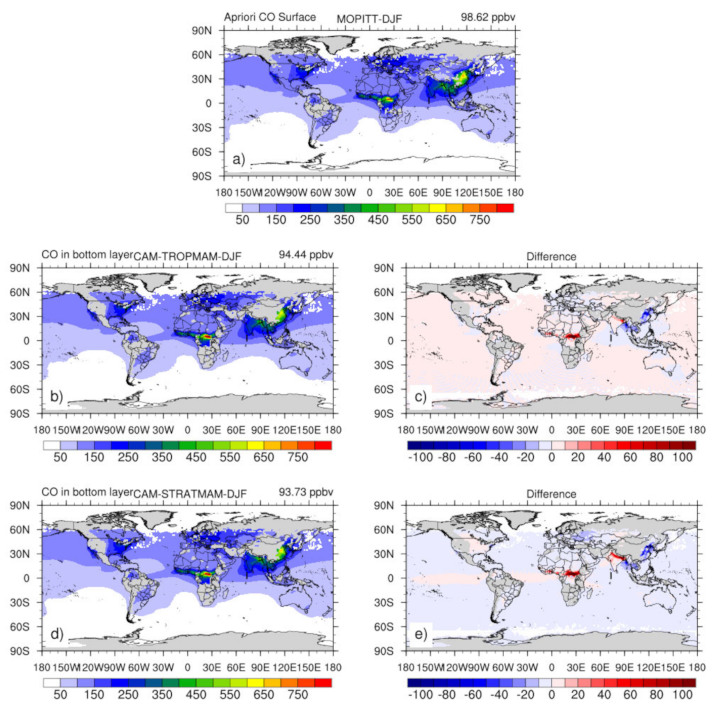
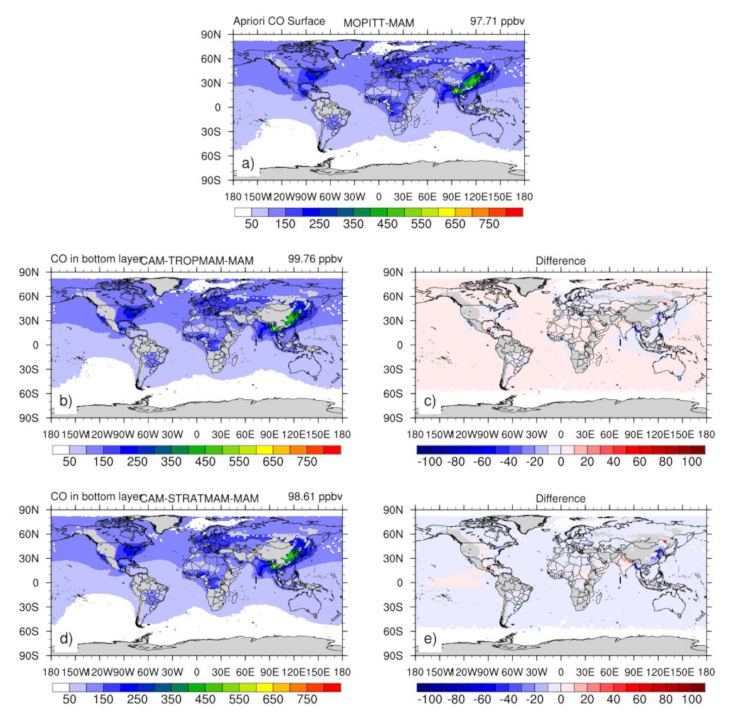
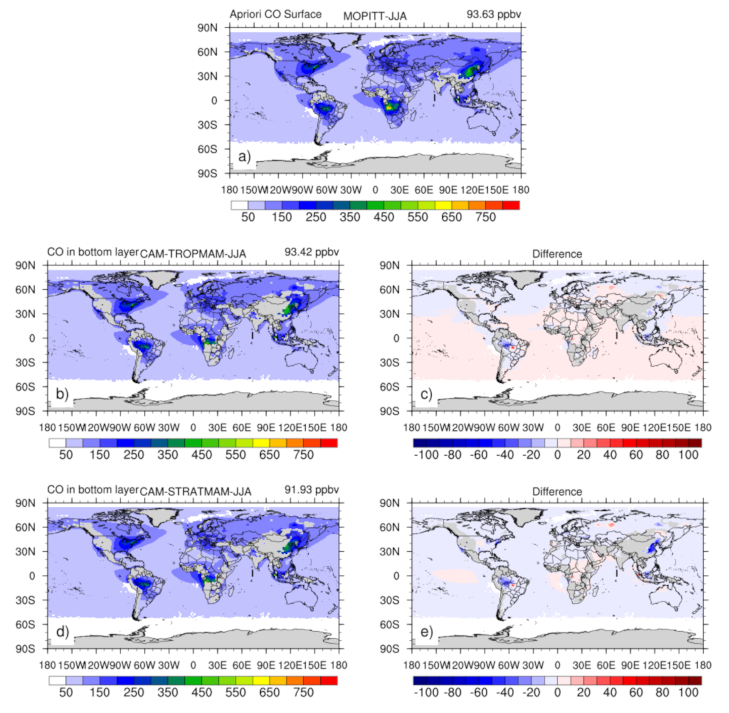
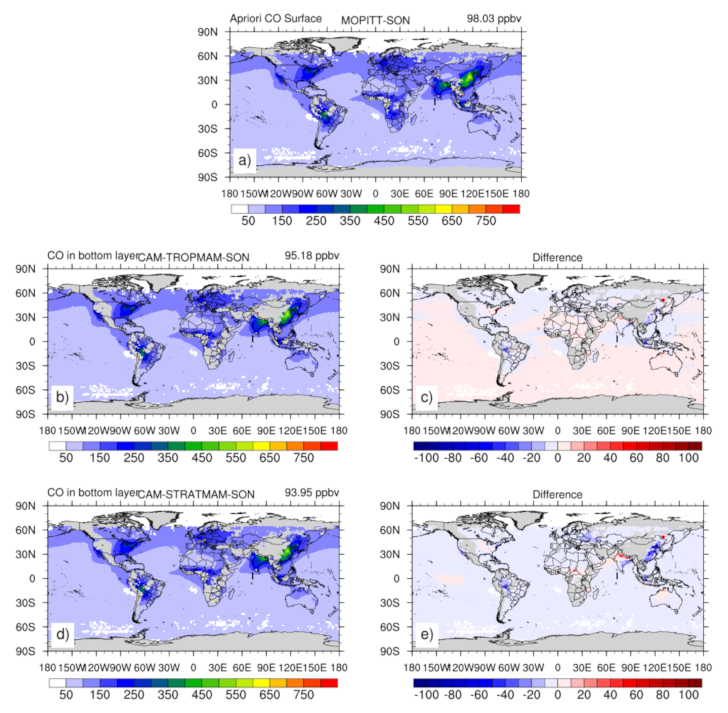
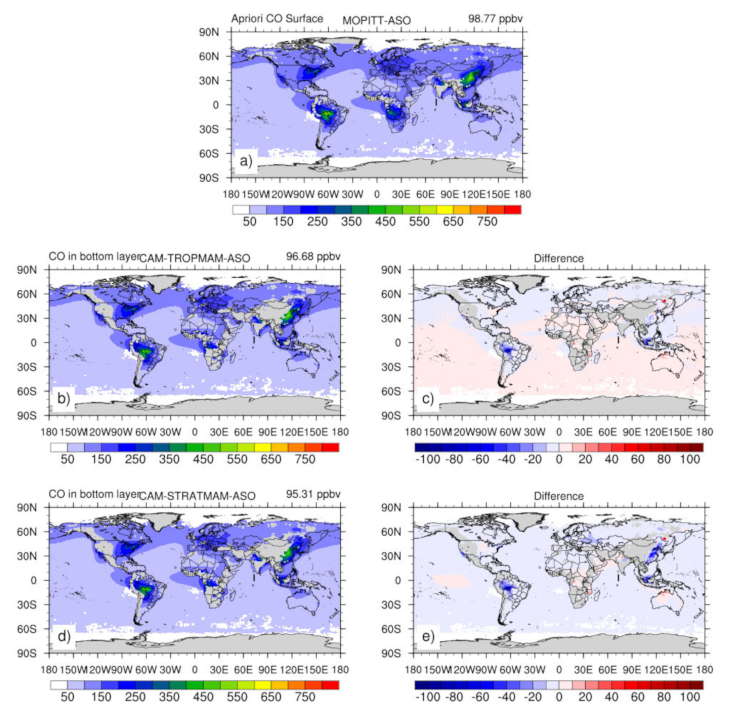
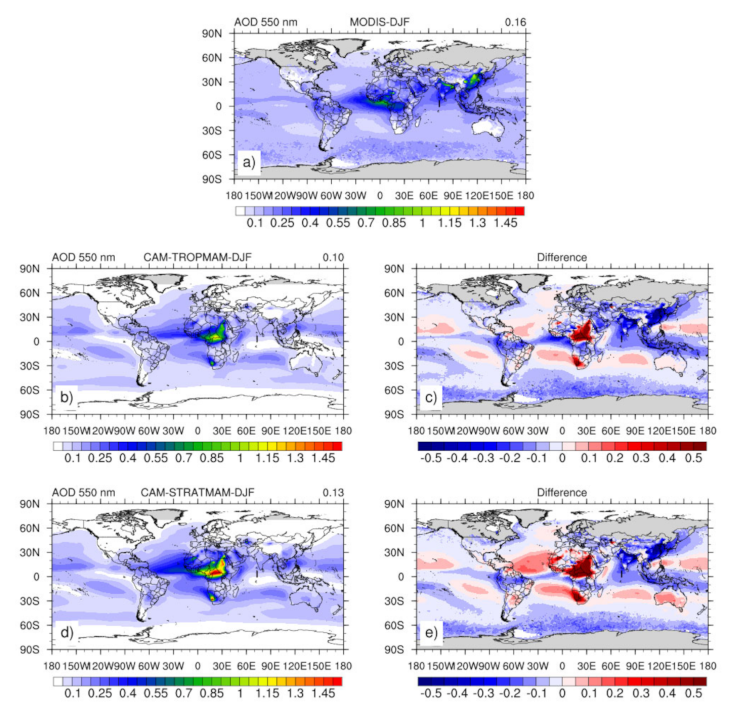



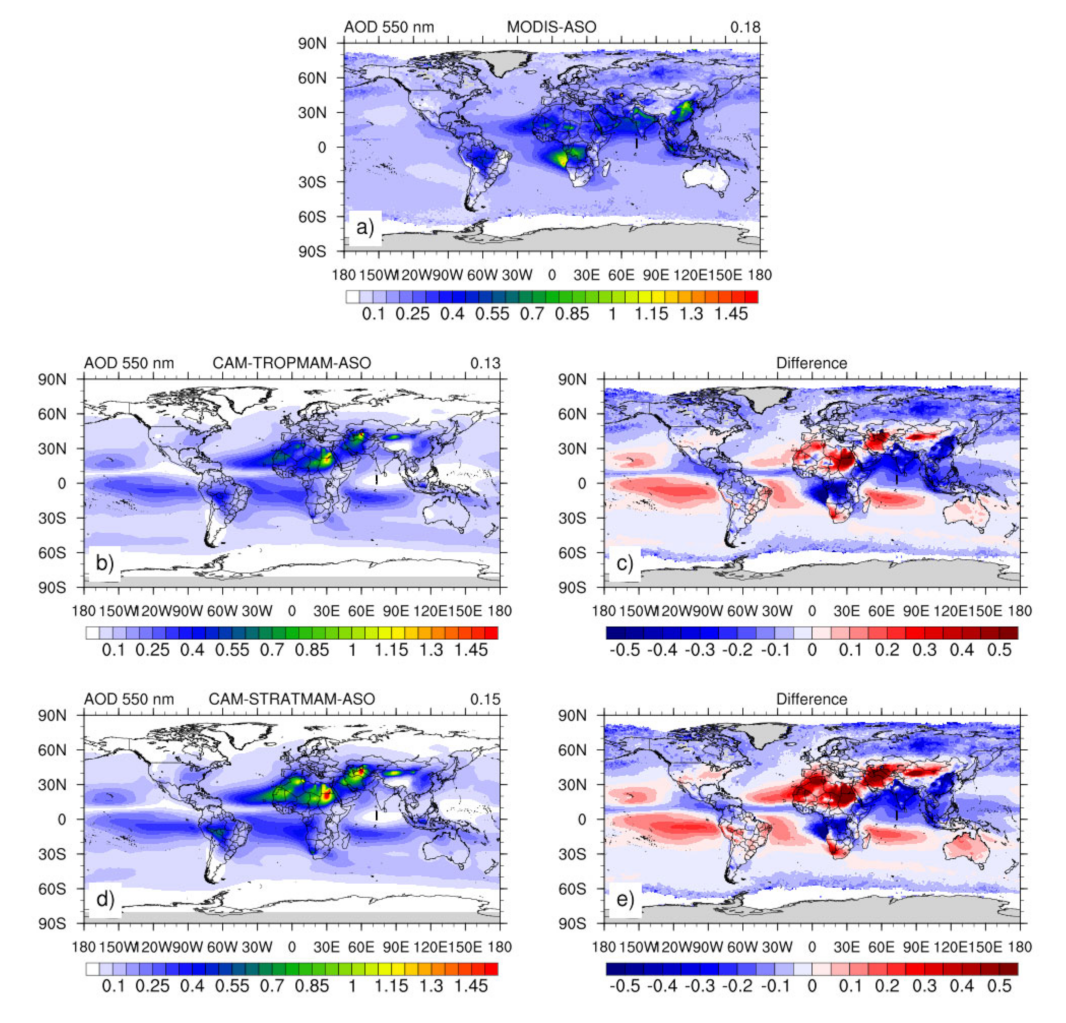
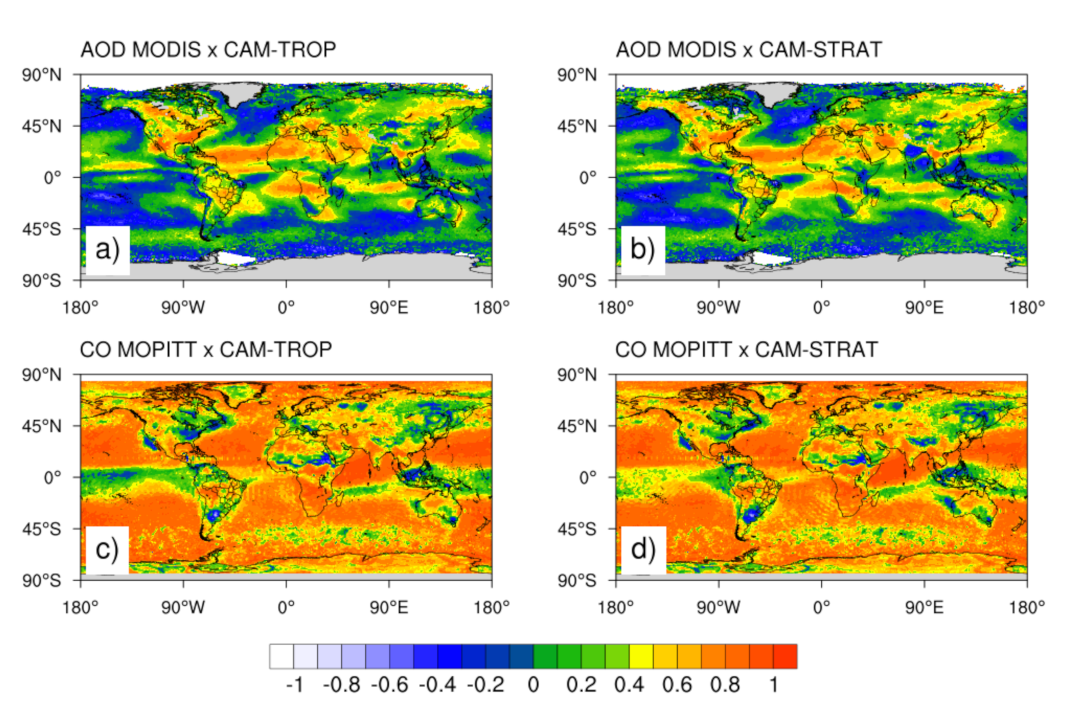
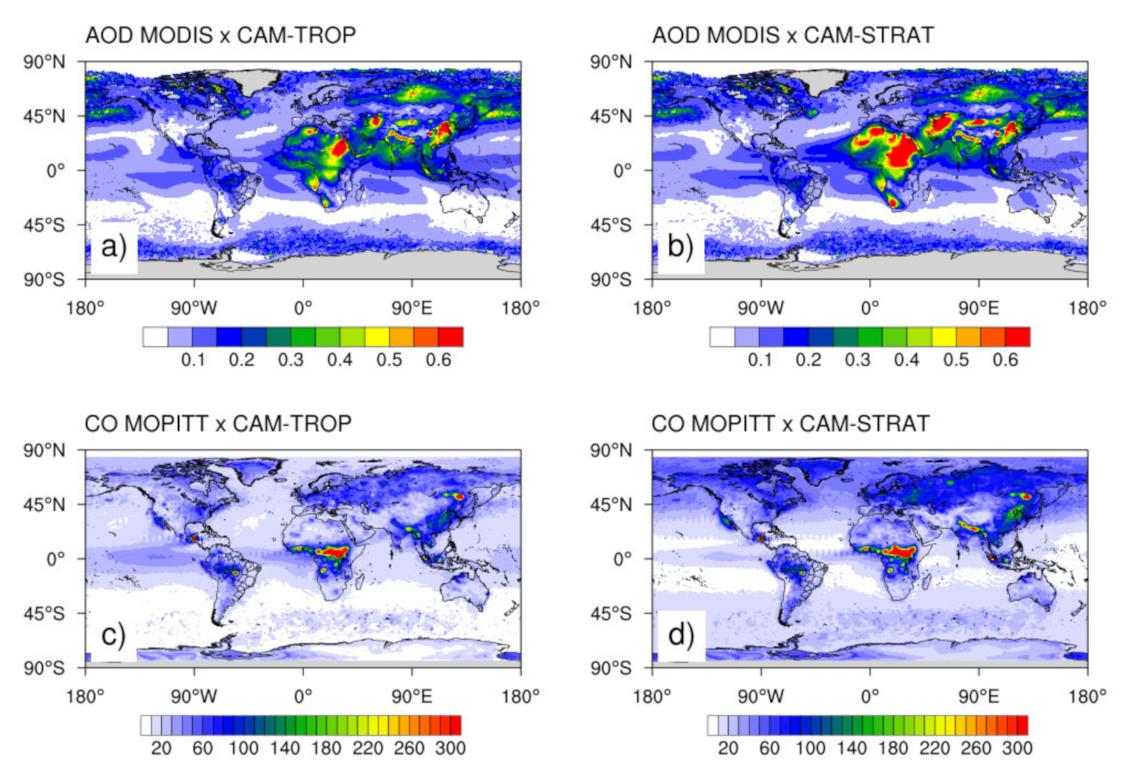
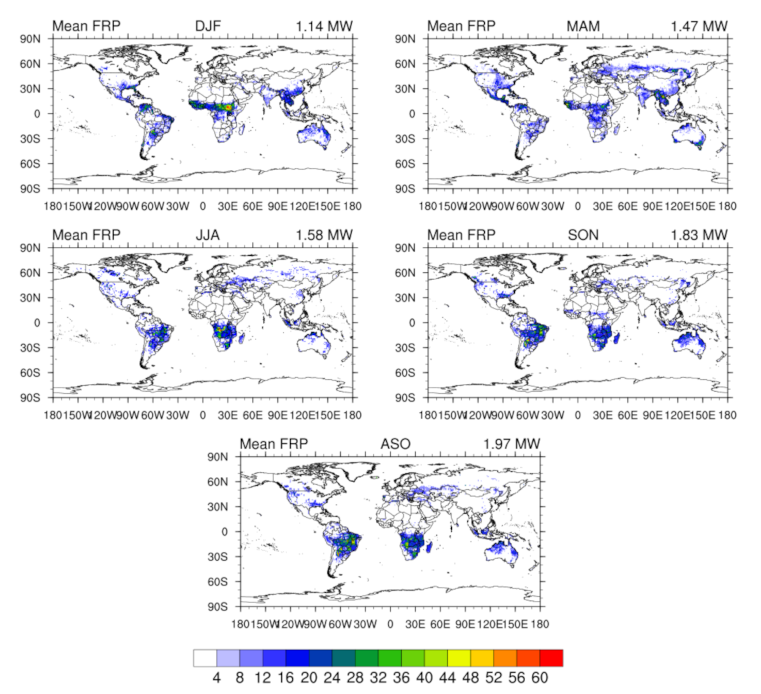
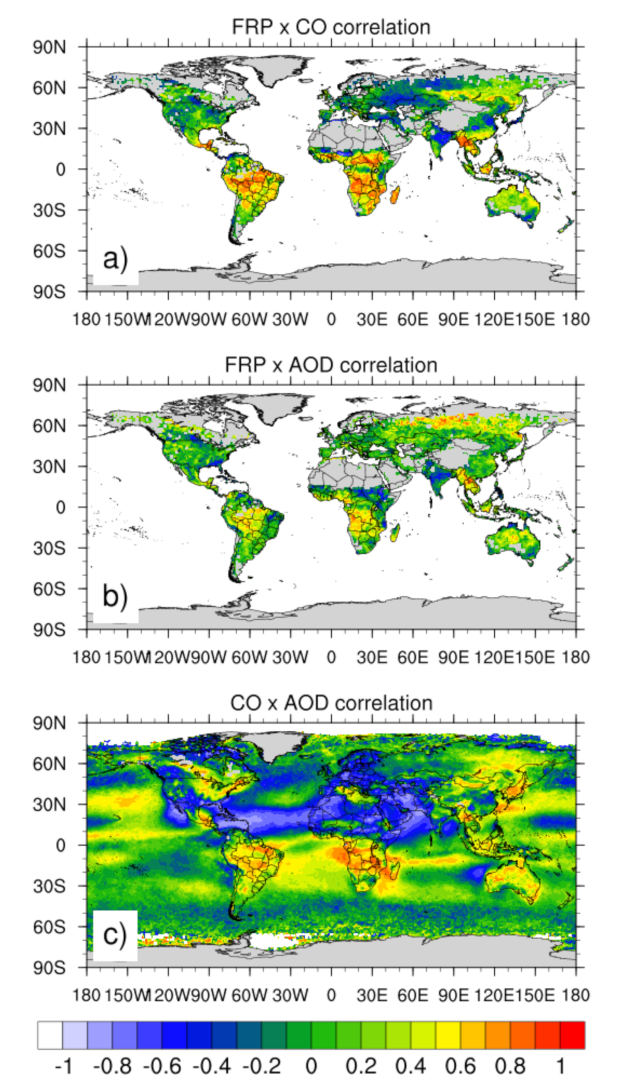
| CAM-TROPMAM | CAM-STRATMAM | |
|---|---|---|
| CO burden (Tg) | 341.919 | 280.386 |
| CO emissions (Tg/year) | 1116.925 | 1116.925 |
| CO dry deposition (Tg/year) | - | 118.412 |
| CO loss by chemical reaction (Tg/year) | 1464.426 | 1522.102 |
| CO lifetime (years) | 0.233 | 0.171 |
| CAM-TROPMAM | CAM-STRATMAM | |
|---|---|---|
| Black carbon aerosol burden (g/m2 year) | 18.44 | 18.67 |
| Dust aerosol burden (g/m2 year) | 6130.85 | 9382.13 |
| Particulate organic matter burden (g/m2 year) | 131.76 | 133.05 |
| Sea salt aerosol burden (g/m2 year) | 2438.23 | 2425.96 |
| Sulfate aerosol burden (g/m2 year) | 361.53 | 366.75 |
| Secondary organic aerosol burden (g/m2 year) | 234.62 | 371.45 |
| CO (Observed) | CO (Modeled) TROPMAM | CO (Modeled) STRATMAM | AOD (Observed) | AOD (Modeled) TROPMAM | AOD (Modeled) SSTRATMAM | |
|---|---|---|---|---|---|---|
| DJF | 98.62 ± 1.17 | 94.44 ± 4.65 | 93.73 ± 4.10 | 0.16 ± 0.02 | 0.10 ± 0.02 | 0.13 ± 0.02 |
| MAM | 97.71 ± 0.84 | 99.76 ± 2.99 | 98.61 ± 2.70 | 0.18 ± 0.02 | 0.12 ± 0.02 | 0.15 ± 0.03 |
| JJA | 93.63 ± 0.70 | 93.42 ± 2.77 | 91.93 ± 2.67 | 0.19 ± 0.02 | 0.15 ± 0.02 | 0.18 ± 0.03 |
| SON | 98.03 ± 0.81 | 95.18 ± 2.95 | 93.95 ± 2.46 | 0.16 ± 0.02 | 0.11 ± 0.02 | 0.13 ± 0.02 |
| ASO | 98.77 ± 0.76 | 96.68 ± 3.10 | 95.31 ± 2.65 | 0.18 ± 0.02 | 0.13 ± 0.02 | 0.15 ± 0.02 |
Publisher’s Note: MDPI stays neutral with regard to jurisdictional claims in published maps and institutional affiliations. |
© 2021 by the authors. Licensee MDPI, Basel, Switzerland. This article is an open access article distributed under the terms and conditions of the Creative Commons Attribution (CC BY) license (https://creativecommons.org/licenses/by/4.0/).
Share and Cite
Alvim, D.S.; Chiquetto, J.B.; D’Amelio, M.T.S.; Khalid, B.; Herdies, D.L.; Pendharkar, J.; Corrêa, S.M.; Figueroa, S.N.; Frassoni, A.; Capistrano, V.B.; et al. Evaluating Carbon Monoxide and Aerosol Optical Depth Simulations from CAM-Chem Using Satellite Observations. Remote Sens. 2021, 13, 2231. https://doi.org/10.3390/rs13112231
Alvim DS, Chiquetto JB, D’Amelio MTS, Khalid B, Herdies DL, Pendharkar J, Corrêa SM, Figueroa SN, Frassoni A, Capistrano VB, et al. Evaluating Carbon Monoxide and Aerosol Optical Depth Simulations from CAM-Chem Using Satellite Observations. Remote Sensing. 2021; 13(11):2231. https://doi.org/10.3390/rs13112231
Chicago/Turabian StyleAlvim, Débora Souza, Júlio Barboza Chiquetto, Monica Tais Siqueira D’Amelio, Bushra Khalid, Dirceu Luis Herdies, Jayant Pendharkar, Sergio Machado Corrêa, Silvio Nilo Figueroa, Ariane Frassoni, Vinicius Buscioli Capistrano, and et al. 2021. "Evaluating Carbon Monoxide and Aerosol Optical Depth Simulations from CAM-Chem Using Satellite Observations" Remote Sensing 13, no. 11: 2231. https://doi.org/10.3390/rs13112231
APA StyleAlvim, D. S., Chiquetto, J. B., D’Amelio, M. T. S., Khalid, B., Herdies, D. L., Pendharkar, J., Corrêa, S. M., Figueroa, S. N., Frassoni, A., Capistrano, V. B., Boian, C., Kubota, P. Y., & Nobre, P. (2021). Evaluating Carbon Monoxide and Aerosol Optical Depth Simulations from CAM-Chem Using Satellite Observations. Remote Sensing, 13(11), 2231. https://doi.org/10.3390/rs13112231






